March 26 through April 16, 2000
Rome
St. Peter in Chains: Michelangelo's Moses is here. On this trip, I noticed I was more humbled by Michelangelo's genius.
Basilica of Santa Maria Spra Minerva: Most memorable: Filippino Lippi"s Annunication with St. Thomas Aquinas, reminds me of 19th century English revival painting of similar themes.
Santa Maria della Vittoria: All those years of art history, finally got to see it: Bernini's Ecstasy of St. Teresa, decadence and high drama!
Basilica of Saint Mary of the Angels and Martyrs: The most memorable thing is Michelangelo transformed an ancient bath into this church, the work actually continued into the 70s! A study in symmetry and perfection.
Santa Maria del Popolo (Saint Mary of the People): I came here to see two stunning Caravaggio's, The Crucifixion of St. Peter and The Mystery of the Conversion of St. Paul, both dynamic, but unfortunately not lit that well.
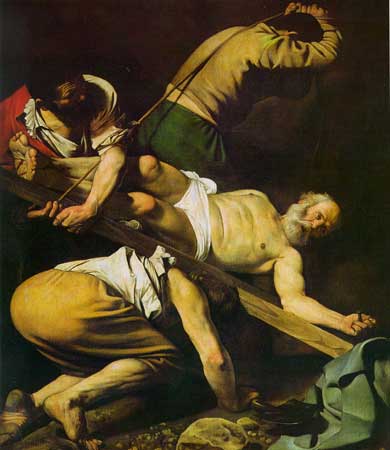 |
|
The
Crucifixion of St. Peter
by Caravagio.
|
San Giovanni (St. John) in Laterano: This is a huge, imposing church, one of the four patriarchal basilicas. There is a fragment of a fresco by Giotto (supposedly), which, because of its condition looks more like a mirage!
Santa Maria Maggiore (St. Mary Major) Basilica: Looks more like a civic building. Precious 5th-century mosaics inside. This church is the ultimate in decadence!
The Vatican: I was enamored with The Map Room, medieval maps of Italy. In addition, small vignettes of Italian towns are inserted as well.
The Capuchin Cemetery: A must for all lovers of the macabre, such as myself. Started in the 1600s, this "cemetery" underneath the Church is actually an elaborate display of the monks' bones who were members of this order. They are displayed in a "stucco" style!
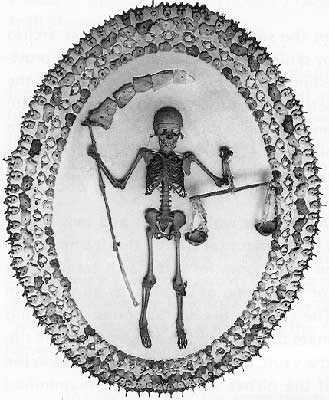 |
|
One
of the ceiling decorations inside - yes, those are human bones!
|
Florence
Uffizi: This was my second time here, and of course, I was stunned by all the famous paintings. But, on this trip I re-discovered the art of "grotesque", decoration on plaster that occupies entire ceilings. I was fascinated by the fanciful mural decorations that mixed animal and human forms and floral ornament. Occasionally, you discover a small vignette, a landscape or city-scene which reminded me of the magic realism of Diego Rivera or Remedios Varo.
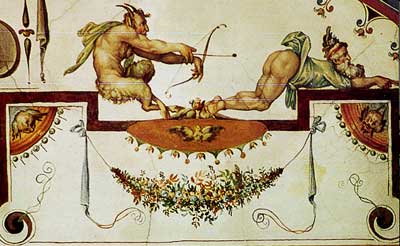 |
|
This
is a grotesque from the Uffizi
|
Church of Santa Croce: First of all, Michelangelo is buried here, and of course, I had a moment of transmutation with the dead. The most significant thing is the Giotto frescoes: how these things were painted in the 1300s is unfathomable! Although a Byzantine influence is present, these figures are in the round and have sculptural, almost mannerist presence! Also noteworthy are the (Agnolo) Gaddi frescoes, The Legend of the True Cross, which are two generations away from Giotto, but more reductive and geometric!
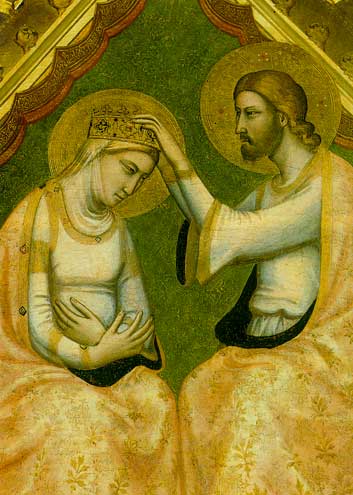 |
|
Baroncelli
Polyptych,
central panel with the Coronation of the Virgin, detail, by Giotto.
|
The Brancacci Chapel: Recently restored, this is one of those experiences which is all-encompassing, a window on the artistic pulse of the Florentine Renaissance. The most poignant image is Masaccio's Expulsion from the Garden of Eden, a timeless portrayal of the agony of being human.
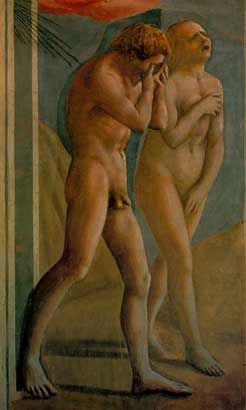 |
|
Explusion
from the Garden
by Masaccio
|
The Medici-Riccardi Palace: These chapel frescoes by Benozzo Gozzoli were a revelation to me, I had not seen them on my first trip to Italy. These frescoes portray the story of the Magi and are completely magical and should not be missed! These are fairy-tale depictions of this famous tale; however, all of the faces (some whose gaze engages you) belong to well-heeled people of Florence at the time. There are beautiful, almost pastoral landscapes in the backgrounds. In addition, there are spectacular depictions of animal life; cheetahs and a falcon clutching its prey. Beautiful, fairy-tale-like presence.
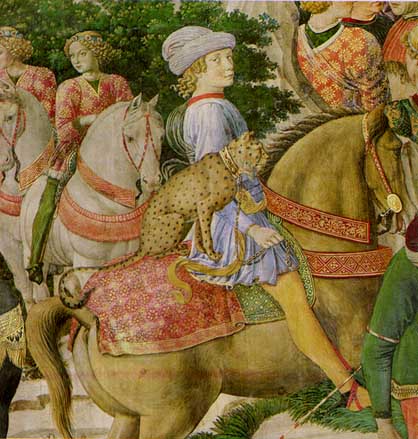 |
|
The
Story of the Magi
(detail) by Benozzo.
|
San Marco: In addition to Benozzo's frescoes, Fra Angelico' cells here represent the color and light of the Italian Renaissance to me. Most amazing is the feeling of spirituality here. By far, the most amazing image is The Mocking of Christ which has the appearance of a post-modern deconstruction of the elements of Christs' tormenters.
 |
|
The
Mocking of Christ
by Beato Angelico.
|
The Church of Santa Felicita: I had forgotten about Pontormo, whose Deposition from the Cross is here. This as an ecstatic, neurotic depiction with shrill color not unlike Michelangelo's Sistine Chapel. Modern and enduring. The color and depth remind me of George Tooker's modern temperas.
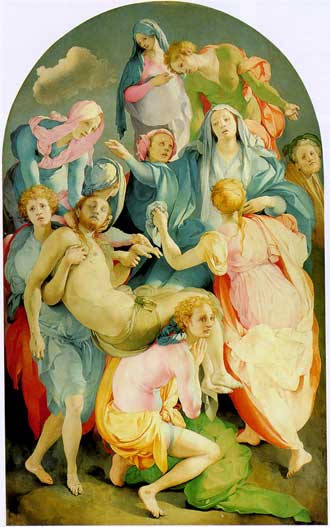 |
|
The
Deposition
by Pontormo.
|
Santa Maria Novella: I think this is my favorite church in Florence because both times I have stayed close to it and was able to visit more than once on each occasion. This time I was able to see the cloister which has vestiges of Uccello's frescoes, Biblical themes: Creation of Adam, Drunkennes of Noah, Original Sin. I could not take my eyes off them. They appeared monochromatic, although that may have been from the decay. I found them timeless not unlike the modern narrative of Thomas Hart Benton or Diego Rivera. I also got to see The Spanish Chapel in which there is an incredible fresco of the Descent of Christ to Limbo, which has wonderful depictions of devil-like creatures.
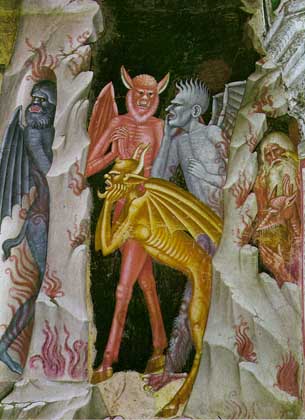 |
|
Descent
of Christ to Limbo (detail) by Andrea di Bonaiuto.
|
San Miniato: High on a hill, this is a great place to go for a great view of Florence. This church is sparce by comparison.
Palazzo Vecchio: Incredible ceiling decorations and more grotesques!
Venice
Basilica of Saints John and Paul (Zanipolo): Completed in 1368, this church has 25 doges buried here. The highlight is Giovanni Bellini's frescoes, an exercise in color and light.
Santa Maria in Trastevere: The look of a Byzantine church inside with mosaics resembling ancient styles.
Accademia Galleries: An encyclopedic look at Venetian painting whose stylistic variations from the Florentine Renaissance was a revelation. Much more drama and theatricality, of course. Favorite paintings: Mantegna's Saint George and Lorenzo Lotto's Portrait of a Gentleman in His Study, almost Vermeer-like in its lush surfaces.
Ca' d'Oro: A relatively small museum in Venice. The highlight was Mantegna's Saint Sebastian. His images evoke the somber melancholy of Durer, a diversion from the idealistic figures of the Florentine Renaissance.
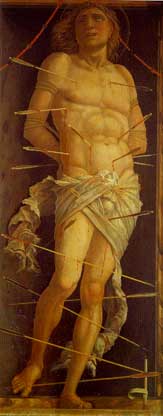 |
| San Sebastiano by Andrea Mantegna |
The Frari's Basilica: This church is almost entirely huge, decadent monuments, including Titian, nothing like resting in such high style!
St. Mark's Basilica: Overwhelming, the most obvious thing is that this has an Eastern influence, totally surprising!
Scuola Grande of San Rocco: Entirely painted by Tintoretto, makes me think of El Greco, very dynamic compositions!
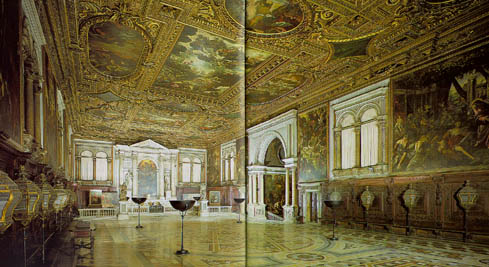 |
|
A
view from inside the Scuolo Grande San Rocco
|
Milan
The Brera Painting Collection: This collection is a must for any artist, especially painters, Piero della Francesca's Madonna with Saints, stunning in its naivete and Renaissance precision. Christ Dead by Mantegna was another one of those images you see over and over in art school. Nothing prepared me for the power of this painting, its hyper-illustrational realism, almost more real than real. I also discovered Crivelli, a meticulous realist. Another discovery was exquisite portraits by Italians which I never heard of: Mazzola, Solario, early 1500s which reminded me of Dutch portaiture.
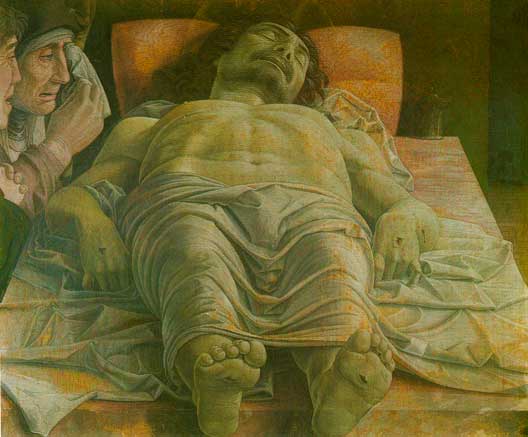 |
|
Christ
Dead by Andrea Mantegna.
|
The Ambrosiana Painting Collection: Like the Brera collection, this is huge, almost encyclopedic! Memorable was a tempera and oil by da Vinci, a portrait of a musician. Stunning! I thought I would be unaffected by the celebrated cartoon for the fresco of Raphael's School of Athens, but these drawings were huge and dramatically lit! I was astonished by Raphael's hand which you could clearly see in these drawings. His paintings and frescoes (of which I have seen) seem more concerned with fashion and style....A Basket of Fruit by Caravaggio brought a tear to my eye, the soul of painting!!!!!
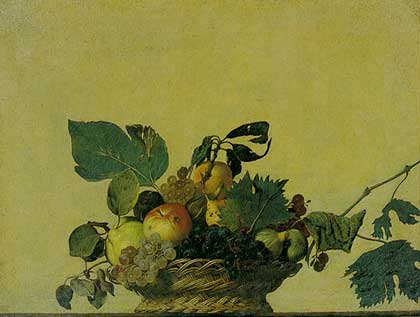 |
|
Basket
of Fruit by Carravagio.
|
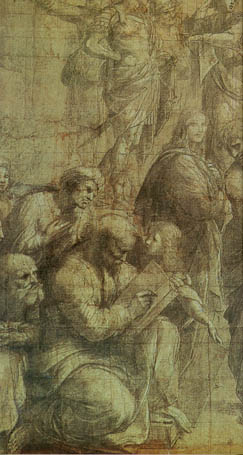 |
|
School
of Athens (detail) by Raphaelo.
|
Send
email to Bob at electricbob@alephnaught.com
Send
email to Aviva at avivakramer@earthlink.net